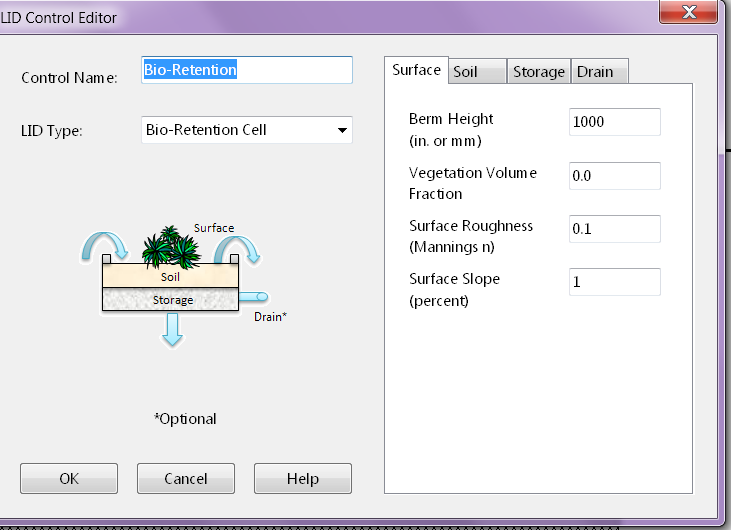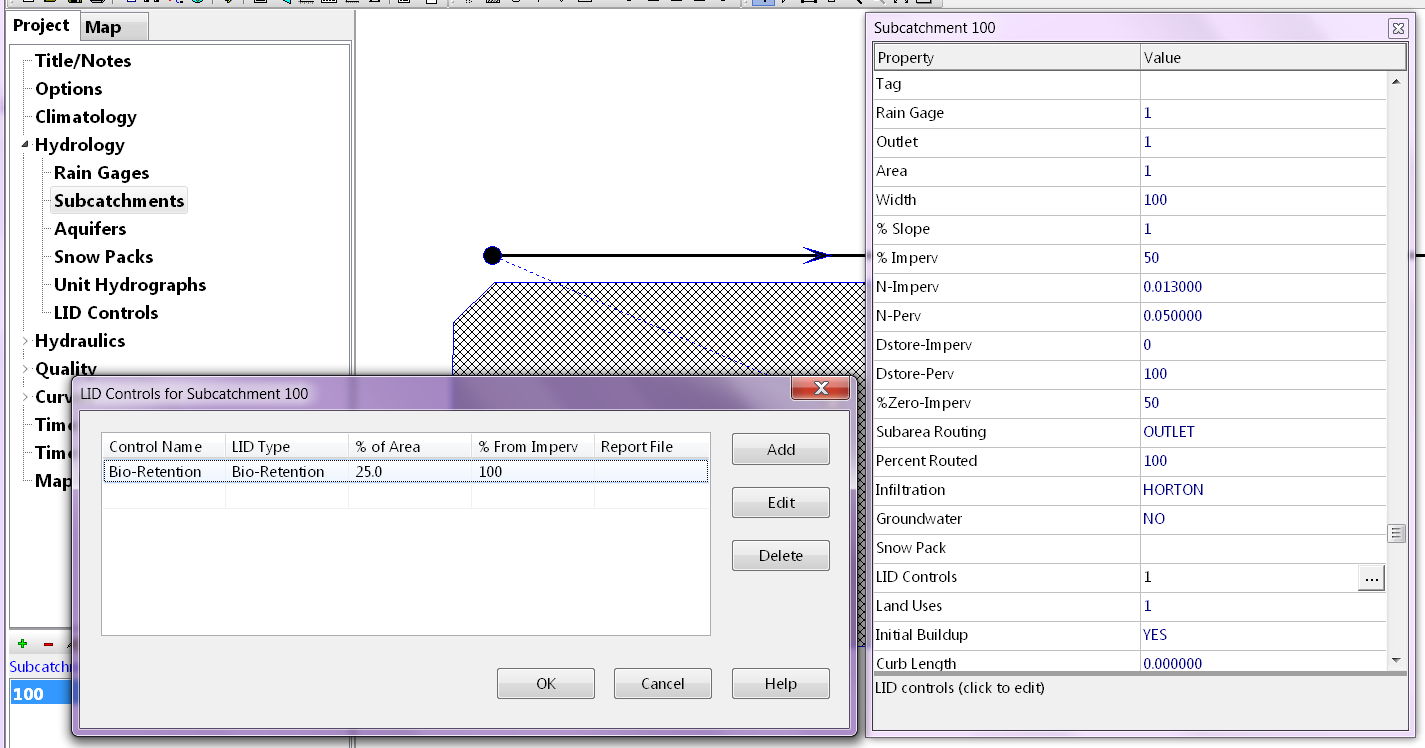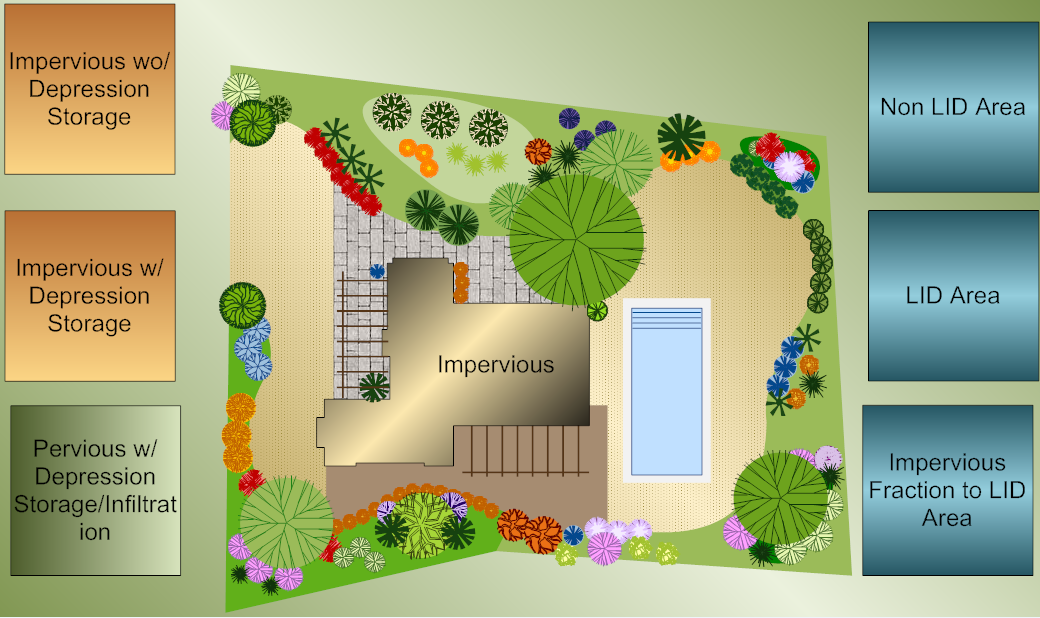Autodesk Technologist with Information about Stormwater Management Model (SWMM) for watershed water quality, hydrology and hydraulics modelers (Note this blog is not associated with the EPA). You will find Blog Posts on the Subjects of SWMM5, ICM SWMM, ICM InfoWorks, InfoSWMM and InfoSewer.
Sunday, April 23, 2017
Area of a Manhole in #SWMM5
Monday, April 17, 2017
Simple SI Unit Model for SWMM5 LID with 100 mm Rainfall - Part 2
#SWMM5 Simple 100 mm Rainfall model for #LID modeling - Part 1
;;Project Title/Notes
LID Model
;;Option Value
FLOW_UNITS CMS
INFILTRATION HORTON
FLOW_ROUTING DYNWAVE
LINK_OFFSETS DEPTH
MIN_SLOPE 0
ALLOW_PONDING YES
SKIP_STEADY_STATE NO
START_TIME 00:00:00
REPORT_START_DATE 03/22/2017
REPORT_START_TIME 00:00:00
END_DATE 03/23/2017
END_TIME 00:00:00
SWEEP_START 01/01
SWEEP_END 01/03
DRY_DAYS 0
REPORT_STEP 00:05:00
WET_STEP 00:05:00
DRY_STEP 01:00:00
ROUTING_STEP 0:00:05
NORMAL_FLOW_LIMITED BOTH
FORCE_MAIN_EQUATION H-W
VARIABLE_STEP 0.75
LENGTHENING_STEP 0
MIN_SURFAREA 1.14
MAX_TRIALS 8
HEAD_TOLERANCE 0.0015
SYS_FLOW_TOL 5
LAT_FLOW_TOL 5
MINIMUM_STEP 0.5
THREADS 1
;;Data Source Parameters
;;-------------- ----------------
CONSTANT 0.0
DRY_ONLY NO
;;Name Format Interval SCF Source
;;-------------- --------- ------ ------ ----------
1 INTENSITY 0:05 1.0 TIMESERIES A
;;Name Rain Gage Outlet Area %Imperv Width %Slope CurbLen SnowPack
;;-------------- ---------------- ---------------- -------- -------- -------- -------- -------- ----------------
; Name Raingage Outlet Area %Imperv Width Slope Clength
100 1 1 1 50 100 1 0.000000
;;Subcatchment N-Imperv N-Perv S-Imperv S-Perv PctZero RouteTo PctRouted
;;-------------- ---------- ---------- ---------- ---------- ---------- ---------- ----------
100 0.013000 0.050000 0 100 50 OUTLET
;;Subcatchment MaxRate MinRate Decay DryTime MaxInfil
;;-------------- ---------- ---------- ---------- ---------- ----------
100 50 10 1 999.000000 0.000000
;;Name Type/Layer Parameters
;;-------------- ---------- ----------
Bio-Retention BC
Bio-Retention SURFACE 1000 0.0 0.1 1 5
Bio-Retention SOIL 1000 .5 .25 .10 10 10.0 100
Bio-Retention STORAGE 1000 0.1 0 0
Bio-Retention DRAIN 0 0.5 0 6
;;Subcatchment LID Process Number Area Width InitSat FromImp ToPerv RptFile DrainTo
;;-------------- ---------------- ------- ---------- ---------- ---------- ---------- ---------- ------------------------ ----------------
100 Bio-Retention 1 2500 10 0 100 0
;;Name Elevation MaxDepth InitDepth SurDepth Aponded
;;-------------- ---------- ---------- ---------- ---------- ----------
2 101 4.342740 0.000000 0.000000 0.000000
1 102 7.298640 0.000000 0.000000 80000.000000
;;Name Elevation Type Stage Data Gated Route To
;;-------------- ---------- ---------- ---------------- -------- ----------------
3 100 FREE NO
;;Name From Node To Node Length Roughness InOffset OutOffset InitFlow MaxFlow
;;-------------- ---------------- ---------------- ---------- ---------- ---------- ---------- ---------- ----------
12 1 2 100 .01 0.000000 0.000000 0.000000 0
23 2 3 100 .01 0.000000 0.000000 0.000000 0
;;Link Shape Geom1 Geom2 Geom3 Geom4 Barrels Culvert
;;-------------- ------------ ---------------- ---------- ---------- ---------- ---------- ----------
12 CIRCULAR 1 0.000000 0.000000 0.000000 1
23 RECT_CLOSED 1 1.600000 0.000000 0.000000 1
;;Link Kentry Kexit Kavg Flap Gate Seepage
;;-------------- ---------- ---------- ---------- ---------- ----------
12 0 0 0.000000 NO 0
23 0 0 0.000000 NO 0
;;Name Units Crain Cgw Crdii Kdecay SnowOnly Co-Pollutant Co-Frac Cdwf Cinit
;;-------------- ------ ---------- ---------- ---------- ---------- ---------- ---------------- ---------- ---------- ----------
SF1 MG/L 0 0.0 0.0 0.0 NO * 0.0 0.0 0.0
;; Sweeping Fraction Last
;;Name Interval Available Swept
;;-------------- ---------- ---------- ----------
A 0 0 0
;;Subcatchment Land Use Percent
;;-------------- ---------------- ----------
100 A 100
;;Subcatchment Pollutant Buildup
;;-------------- ---------------- ----------
100 SF1 40
;;Land Use Pollutant Function Coeff1 Coeff2 Coeff3 Per Unit
;;-------------- ---------------- ---------- ---------- ---------- ---------- ----------
A SF1 POW 0.0 1 1 AREA
;;Land Use Pollutant Function Coeff1 Coeff2 SweepRmvl BmpRmvl
;;-------------- ---------------- ---------- ---------- ---------- ---------- ----------
A SF1 EXP 1 1 0.0 0.0
;;Name Date Time Value
;;-------------- ---------- ---------- ----------
A 00:00 0
A 00:05 9.573452431
A 00:10 10.25274205
A 00:15 11.04623792
A 00:20 11.98563822
A 00:25 13.11546308
A 00:30 14.50019616
A 00:35 16.2367101
A 00:40 18.47713325
A 00:45 21.47391061
A 00:50 25.67639064
A 00:55 31.96236514
A 01:00 42.28290598
A 01:05 61.90323665
A 01:10 110.6596749
A 01:15 202.1863528
A 01:20 122.9825837
A 01:25 78.78745972
A 01:30 57.07434496
A 01:35 44.44627995
A 01:40 36.29030405
A 01:45 30.63131568
A 01:50 26.49481575
A 01:55 23.34912428
A 02:00 20.88150483
A 02:05 18.89679137
A 02:10 17.26739526
A 02:15 15.9065854
A 02:20 14.75345383
A 02:25 13.76406613
A 02:30 12.9059759
A 02:35 12.15470506
A 02:40 11.49147541
A 02:45 10.90163374
A 02:50 10.37359955
A 02:55 9.898093036
A 03:00 9.467598431
;;Reporting Options
INPUT YES
CONTROLS NO
SUBCATCHMENTS ALL
NODES ALL
LINKS ALL
DIMENSIONS 82757.219 8542.173 83495.650 8753.113
Units None
;;Node X-Coord Y-Coord
;;-------------- ------------------ ------------------
2 83134.103 8743.516
1 82811.980 8743.508
3 83462.085 8743.524
;;Link X-Coord Y-Coord
;;-------------- ------------------ ------------------
;;Subcatchment X-Coord Y-Coord
;;-------------- ------------------ ------------------
100 83119.103 8710.484
100 83119.103 8551.761
100 82790.784 8551.761
100 82793.138 8710.780
100 82813.136 8730.484
100 83099.103 8730.484
100 83119.103 8710.484
;;Gage X-Coord Y-Coord
;;-------------- ------------------ ------------------
1 82983.981 8630.926
Friday, April 14, 2017
InfoSWMM SA SWMMLive Manager

- Export Model to SWMMLive - Exports the active InfoSWMM SA model for SWMMLive (InfoSWMM SA) to create a baseline model. All essential information about the active InfoSWMM SA model is exported into the given inp file. If current InfoSWMM SA model contains scenario data, this option can be used in conjunction with selected scenarios to export scenario-based models with overriding operational scenario data. All scenario-based model inp files will be exported to their respective scenario sub-folders under the baseline model path.
- Extend Scenario Data to SWMMLive - Exports additional InfoSWMM SA scenario models based on a provided SWMMLive baseline model. The operational data from the selected scenarios will be merged into the given SWMMLive reference model to form different scenario models, to be used in SWMMLive. All scenario-based model inp files will be exported to their respective sub-folders under the given baseline model path.
- Diagnose SWMMLive Model - Diagnoses a given SWMMLive model using the full utilities available from InfoSWMM SA. The given SWMMLive model is imported into InfoSWMM SA for any diagnosis analysis in InfoSWMM SA.

Export Model to SWMMLive
 Browse for a folder location and specify an inp file name.
Browse for a folder location and specify an inp file name.Thursday, April 13, 2017
How can there be more flow in a pipe than its full capacity? #SWMM5 and #InfoSWMM - Emoji View
🌊🌀 Unraveling the Pipe Capacity Enigmas of #SWMM5, ICM InfoWorks & ICM SWMM 🚀🌐
📌 Spotlight on Innovyze: Our enlightening journey today seamlessly blends knowledge from the Innovyze blog, tailored especially for the champions of #SWMM5, ICM InfoWorks, and ICM SWMM! 🔍🔗 Innovyze Blog Post
🤔💡 Puzzling Pipe Phenomenon: Ever had those perplexing moments 🙆♂️ when, within #SWMM5 or ICM platforms, a surcharged pipe's maximum simulation flow exceeds its full capacity? Sounds baffling, right? How does more water flow than the pipe's capacity? 🌊🔍
📊 Deciphering Qfull: In #SWMM5 and its ICM counterparts, Qfull (from the link input summary table) is sourced from the revered Manning's equation 📜. While this equation is foundational, it's a tad simpler than the intricate St Venant equations 🧮 harnessed by the engines of SWMM5, ICM InfoWorks, and ICM SWMM for model outputs. This leads to minor variances between Qfull (dictated by slope) and the actual flow discharge as determined by the 1D St Venant Equations. Crucial insight: Qfull serves as a handy reference for us, the users 🧑💻, and isn't the engine's yardstick for determining pipe surcharge. 🖥️🔗
🧐 Manning's Equation Unveiled: Manning's equation paints a picture of a pipe that stretches limitlessly 🌌. Resultantly, it's common for a pipe to ferry more water than its nominal capacity sans surcharge. Want a litmus test? 🕵️♂️ Extend your pipe or stick to a constant max flow, and voilà, brace yourself for the surcharge spectacle! 🌊🎢
📏✨ The Influence of Length: Pipe length isn't just a number; it's a game-changer! 🚀 A nimble 10-meter pipe might effortlessly channel a flow that its 100-meter sibling grapples with, even if they mirror each other in gradient, roughness, and other traits. It all boils down to friction loss, which magnifies with length! 📈🔥
🎉🎈 Golden Nuggets: As stewards of water 💧 and aficionados of #SWMM5, ICM InfoWorks, and ICM SWMM, it's pivotal to fathom that every modeling marvel, be it SWMM or ICM, amalgamates both time-tested wisdom and sophisticated computations. At times, they might seem at odds, but a deeper dive (literally!) can illuminate and elevate our comprehension! 🌟📚🌍
Stay inquisitive, embrace experimentation, and let's champion the cause of seamless water flow! 🌍🌊🤓🎉🥳🌱🌟🎈📊🌈🚀🌐🔍🔗🌀📜🧮🖥️🧑💻🙆♂️🕵️♂️🎢🚀📏🔥🎊📚🌟🎉🌍🌊🤓🎈🎉🎊🌱🌟🎈📊🌈🚀🌐🔍🔗🌀📜🧮🖥️🧑💻🙆♂️🕵️♂️🎢🚀📏🔥🎊📚🌟🎉🌍🌊🤓🎈🎉🎊🌱🌟🎈📊🌈🚀🌐🔍🔗🌀📜🧮🖥️🧑💻🙆♂️🕵️♂️🎢🚀📏🔥🎊📚🌟🎉🌍🌊🤓🎈🎉🎊🌱🌟🎈📊🌈🚀🌐🔍🔗🌀📜🧮🖥️🧑💻🙆♂️🕵️♂️🎢🚀📏🔥🎊📚🌟🎉🌍🌊🤓🎈🎉🎊🌱🌟🎈📊🌈🚀🌐🔍🔗🌀📜🧮🖥️🧑💻🙆♂️🕵️♂️🎢🚀📏🔥🎊📚🌟🎉🌍🌊🤓🎈🎉🎊🌱🌟🎈📊🌈🚀🌐🔍🔗🌀📜🧮🖥️🧑💻🙆♂️🕵️♂️🎢🚀📏🔥🎊📚🌟🎉🌍🌊🤓🎈🎉🎊🌱🌟🎈📊🌈🚀🌐🔍🔗🌀📜🧮🖥️🧑💻🙆♂️🕵️♂️🎢🚀📏🔥🎊📚🌟🎉🌍🌊🤓🎈🎉🎊🌱🌟🎈📊🌈🚀🌐🔍🔗🌀📜🧮🖥️🧑💻🙆♂️
Tuesday, April 4, 2017
Use Sublime Text to Diff two files in the same folder for SWMM 5 C Code
Sunday, April 2, 2017
EPA #SWMM5 Build 5.1.012 (03/14/17) Updates
SWMM 5.1 Update History
=======================
https://www.epa.gov/water-research/storm-water-management-model-swmm#downloads
------------------------
Build 5.1.012 (03/14/17)
------------------------
Engine Updates:
1. The direct.h header is now only #included in the swmm5.c file when
compiled for Windows. (swmm5.c)
2. Engine Update #7 in Build 5.1.011 (internally aligning the wet time
step with the reporting time step) was redacted since it caused
problems for certain combinations of time steps. (runoff.c)
3. A subcatchment's bottom elevation is now used instead its parent
aquifer's value when saving a water table value to the binary results
file. (subcatch.c)
4. A bug that failed to limit surface inflitration into a saturated rain
garden LID unit was fixed. (lidproc.c)
5. Calculation of the maximum limit on LID drain flows was modified to
produce smoother results at low depths above the drain offset.
(lidproc.c)
6. A variable used for reporting detailed LID results is now properly
initialized. (lid.c & lid.h)
7. The occasional writing of duplicate lines to the detailed LID results
file was fixed. (lidproc.c)
8. The conversion from conduit seepage rate per unit area to rate per unit
of length was changed to use top width instead of wetted perimeter since
only vertical seepage is assumed to occur. (link.c)
9. The coefficient of the evaporation/seepage term in the dynamic wave
equation for updating conduit flow was corrected (from 1.5 to 2.5).
(dwflow.c)
10. The Engels flow equation for side flow weirs was corrected (the original
equation used in SWMM 3 & 4 was incorrect). (link.c)
11. Crest length reductions for end contractions are no longer used for
trapezoidal weirs. (link.c)
12. The Slope Correction Factor for culverts with mitered inlets was corrected.
(culvert.c)
13. An entry in the table of gravel roadway weir coefficients was corrected.
(roadway.c)
14. The user supplied minimum slope option is now initialized to 0.0
(meaning none is provided). (project.c)
15. NO/YES are no longer accepted as attributes for the NORMAL_FLOW_LIMITED
dynamic wave simulation option (only SLOPE/FROUDE/BOTH are valid).
(project.c)
16. Changes were made so that the Routing Events and Skip Steady Flow
options work correctly together. (routing.c & globals.h)
17. Steady state periods with no flow routing no longer contribute to the
routing time step statistics. (stats.c and report.c)
18. When compiling statistics on the frequency of full conduit flow the
number of barrels is now accounted for. (stats.c)
19. Under kinematic wave or steady flow routing, the water level in
storage nodes that have no outflow links is now updated correctly
over time. (flowrout.c)
20. The formula for the depth at maximum width for the Modified Basket Handle
cross section was corrected. (xsect.c)
GUI Updates:
1. Profile plots now correctly update the main and axis title text when
changed via the Profile Plot Options dialog. Also the downstream
offset height of non-conduit links is set to 0 on the plot.
2. The LID Control Editor now sets the Storage Layer Thickness to 0 when
a Rain Garden is selected as the type of LID being edited.
3. An OnChange event handler was added to each of the LID Control Editor's
data fields to record when a value is changed.
Graphing Infographic for #InfoSWMM
1. Batch Mode
2. Single Run Manager
3. Changing Scenarios and then using the Single Run Manager
4. Your number one debugging tool is the System graphs, it tells you the total rainfall, runoff, flooding, outflow and storage in one easy to see graph or table
AI Rivers of Wisdom about ICM SWMM
Here's the text "Rivers of Wisdom" formatted with one sentence per line: [Verse 1] 🌊 Beneath the ancient oak, where shadows p...
-
@Innovyze User forum where you can ask questions about our Water and Wastewater Products http://t.co/dwgCOo3fSP pic.twitter.com/R0QKG2dv...
-
Subject: Detention Basin Basics in SWMM 5 What are the basic elements of a detention pond in SWMM 5? They are common in our back...
-
Engine Error Number Description ERROR 101: memory allocation error. ...












